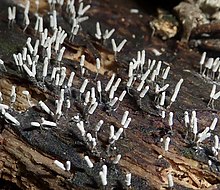Arcyria
| Arcyria | ||||||||||||
|---|---|---|---|---|---|---|---|---|---|---|---|---|

Arcyria denudata , type species of the genus |
||||||||||||
| Systematics | ||||||||||||
|
||||||||||||
| Scientific name | ||||||||||||
| Arcyria | ||||||||||||
| Wiggers |
Arcyria is a genus of slime molds from the order of the Trichiida . With some of its species, it is one of the most geographically and ecologically widespread genera and comprises over 25 species.
features
The mostly gregarious, stalked to sessile fruiting bodies are sporangia (also known as sporocysts), mostly ovoid to approximately cylindrical, rarely spherical, club-shaped or pear-shaped. The stem is filled with spore-like cells. The peridium is membranous, mostly translucent, possibly absent in some species. The approach of the peridium is usually clearly demarcated as a disc-shaped to funnel-shaped calyx and only occasionally reaches into the scalp as a lobe or spot in individual species .
The dense, reticulate capillary is slightly to strongly resilient, and after maturity it expands enormously. It is either grown together over the entire surface of the chalice and remains attached to it or is only connected to it in the middle of the chalice and breaks there. The capillitium has a variety of reliefs, in the form of rings, half-rings, horizontal stripes, spikes, spiral bands or comb-shaped or network-shaped structures.
As a spore mass, the spores are always uniformly colored, colorless or only pale colored in transmitted light . They are round and measure 7 to 10 micrometers in diameter, their surface is smooth, unevenly warty or finely prickly, weak, network-like structures are rarely found.
distribution
The genus Arcyria is widespread worldwide and is considered to be one of the world's most common slime mold genera, some Arcyria species ( Arcyria cinerea, Arcyria denudata, Arcyria incarnata, Arcyria nutans ) are also among the most widespread slime mold species in terms of the breadth of their habitats .
Systematics and research history
The genus was first described by Friedrich Heinrich Wiggers in 1780 , the type species is the Arcyria denudata, still described by Carl von Linné in 1753 as Clathrus denudatus . The division into the two sub-genera Clathroides and Arcyrella introduced by Joszef Tomasz Rostafinski in 1875 is no longer recognized by modern editors. The genus includes over twenty-five species, including:
- Arcyria abietina
- Arcyria affinis
- Arcyria cinerea
- Arcyria corymbosa
- Arcyria denudata
- Arcyria fasciculata
- Arcyria ferruginea
- Arcyria globosa
- Arcyria helvetica
- Arcyria incarnata
- Arcyria insignis
- Arcyria leiocarpa
- Arcyria magna
- Arcyria major
- Arcyria minuta
- Arcyria nepalensis
- Arcyria obvelata
- Arcyria oerstedtii
- Arcyria oerstedtioides
- Arcyria pomiformis
- Arcyria stipata
- Arcyria versicolor
proof
Footnotes directly behind a statement cover the individual statement, footnotes directly behind a punctuation mark the entire preceding sentence. Footnotes after a space refer to the entire preceding paragraph.
- ↑ a b c d e f E. Robbrecht: The Genus Arcyria Wiggers (Myxomycetes) in Belgium In: Bulletin du Jardin botanique national de Belgique / Bulletin van de National Plantentuin van België, Vol. 44, Issue 3/4, 1974, p 303-353
- ↑ a b c d e Marie L. Farr: Myxomycetes . In: Flora Neotropica . tape 16 . The New York Botanical Garden, New York 1976, ISBN 0-89327-009-1 , pp. 67-68 .
- ↑ a b Michael J. Dykstra, Harold W. Keller: Mycetozoa In: John J. Lee, GF Leedale, P. Bradbury (Eds.): An Illustrated Guide to the Protozoa . tape 2 . Allen, Lawrence 2000, ISBN 1-891276-23-9 , pp. 968 .
- ^ Hermann Neubert , Wolfgang Nowotny , Karlheinz Baumann : The Myxomycetes of Germany and the neighboring Alpine region with special consideration of Austria . tape 1 . Karlheinz Baumann Verlag, Gomaringen 1993, ISBN 3-929822-00-8 , p. 166 .


